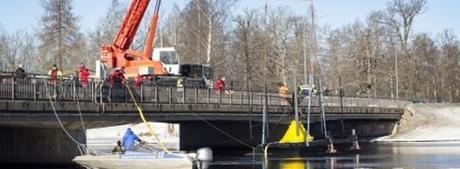
After some preparations a large crane was used to lower the turbine into the river. (Credit: Mikael Wallerstedt)
Experimental vertical-axis hydroelectric turbine has been successfully installed on the bottom of the Dal River in Sweden. “This is like a large laboratory for us. Now we can verify the technology”, says Mats Leijon, Professor of Electricity at Uppsala University. If verified, new turbine design can be applied primarily to harness the power of ocean tides. It could, however, also be used in conjunction with traditional hydropower systems to extract more energy from the rivers.
The preparations began early on Thursday morning on one of the bridges in Söderfors. Before the turbine was lowered into the water using a crane, divers needed to survey the river bed.
When everything was ready for the big lift several journalists and photographers had gathered on the bridge, together with curious locals.
The work was supervised by Professor Mats Leijon and his doctoral students, which have developed the unique technology for capturing current power and producing electricity. The turbine is similar to a wind turbine, but adapted to work with the much slower speeds of the flowing water.
The technology is primarily developed for the large oceans where tidal forces can be utilised, but right now it is being tested in Dalälven.
“This is like a really large laboratory for us. There is a power station further up and one further down the river. We are cooperating with Vattenfall and Fortum and can get continuous information about the water flow”, says Professor Mats Leijon.
It is possible to extract more energy from the Swedish rivers, he says.
“Even in rivers with traditional hydroelectric plants there is a potential for using passive systems. You could increase power production here in Söderfors.”
The experimental plant consists of a vertical axis turbine and a generator connected to a cabin on land with measurement instruments. If all goes well the team will apply for permission to install a second power plant in the same place, but that is still some way off in time.
“First we must verify the technology. We have done experiments with the different parts, but now we will test the whole system. That is always much harder. In the best of worlds the experiments tally with reality and then we have taken engineering a step forward.”
The research on current power has been under way since 2001 and not until now has the hard work started to pay off. The first thesis from the group was finished in December last year. In April and May two more will be ready. The technology for current power has already attracted some international attention, says Mats Leijon.
“We have actually had an offer to set up a power station in a lagoon in the Seychelles, where tidal water rises and falls, which sounded tempting!”
For the time being though, Dalälven will be the main focus point for Mats Leijon and his doctoral students.
Annica Hulth
Thomas, K., Grabbe, M., Yuen, K., & Leijon, M. (2012). A Permanent Magnet Generator for Energy Conversion from Marine Currents: No Load and Load Experiments ISRN Renewable Energy, 2012, 1-7 DOI: 10.5402/2012/489379
